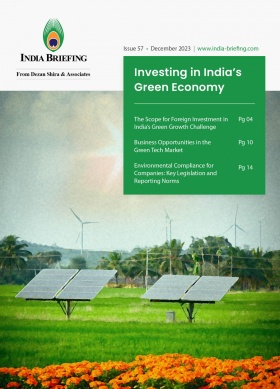How India Plans to Achieve Cost-Effective Green Hydrogen Production
The green hydrogen market in India has yet to have a dedicated statewide network of interconnected hydrogen pipelines. India can take a cue from Europe, which established a dedicated hydrogen transport network by building on its pre-existing gas network (the European Hydrogen Backbone project). There is a great emphasis on green hydrogen as a potential option to decarbonise hard-to-abate sectors, including refineries, ammonia, methanol, iron and steel, and heavy-duty trucks.
What is green hydrogen energy?
Hydrogen is one of the most prevalent elements in nature and has uses in thermal, nuclear, and electrical fields. Although there are various types of hydrogen energy, such as grey and blue hydrogen, the method of producing hydrogen energy through sustainable water sourcing and renewable energy sources is known as “green hydrogen production.” Since green hydrogen is proven to release little to no greenhouse gases, it has become highly favored.
The source has a low density and is a light element—lighter than air—which makes transportation challenging. For this reason, it is liquified to take on a denser form. Green hydrogen may seem like a relatively new idea, but hydrogen energy is among the most ancient energy sources utilized in factories and other businesses.
Webinar – India’s Manufacturing Landscape in 2024: Key Sectors, Challenges, Competitiveness, and Schemes
India Session: March 13, 2024
10:00 AM Brussels / 2:30 PM India Time / 4:00 PM Vietnam Time / 5:00 PM China Time
North America Session: March 14, 2024
9 AM Los Angeles / 12 PM New York / 6 PM Brussels
Join us as Koushan Das, Manager – Business Intelligence, shares insights on India’s manufacturing landscape in 2024 and highlights the importance of emerging sectors, competitiveness in Asia, the importance of MSMEs, and key industrial hubs in the country.
This webinar is FREE of charge.
Race to be the top green hydrogen manufacturer
Renewable energy sources such as solar and wind power have advanced significantly, but they continue to pose challenges. The generation of clean energy via these two sources is very much dependent upon the availability of abundant sunlight and strong winds. In order to replace fossil fuels and achieve decarbonization in industry segments. such as heavy-duty transportation, chemicals, and industry, we need a natural source that can be available year-round, such as hydrogen energy.
Hydrogen, particularly green hydrogen, is being viewed as the next big alternate source of energy revolution. In terms of energy requirements, India’s economy is currently the third largest in the world, and it is estimated that by 2030, the nation’s demand for energy is expected to increase by 35 percent.
|
Countries |
Current hydrogen demand |
Focused hydrogen energy |
Policy target demand |
Capital allocated (US$) |
|
European Union |
Not available |
Low carbon – blue/green |
6GW capacity by 2024; 40 GW by 2030 10 MMTPA green H2 by 2030 |
609 billion |
|
Germany |
1.65 MMTPA |
Carbon free – blue/green |
2.7 – 3.3 MMTPA by 2030 |
15-25 billion |
|
Japan |
2 MMTPA |
Blue |
3 MMTPA by 2030 and 20 MMTPA by 2050 (5-30 by 2050) |
664 million |
|
South Korea |
220 KTPA |
Grey/blue/green |
3.9 MMTPA by 2030 and 27 MMTPA by 2050 |
653 million (annual targeted support for hydrogen project) |
|
United States |
10 MMTPA |
Low carbon – blue/green/others |
Not available |
> 15 billion |
|
Australia |
650 KTPA |
Clean – blue / green |
Not available |
487 million |
|
Chile |
58.5 KTPA |
Green |
5 GW/a(2025) 25 GW/a(2025) |
50 million |
Source: NITI Aayog
Between 2015 and 2018, the global production of green hydrogen amounted to approximately one million metric tons.
While green hydrogen is produced by electrolysing renewable energy sources, blue hydrogen is produced by capturing and storing emissions from fossil fuels like natural gas, making it carbon neutral. It is projected that the production of blue hydrogen will reach 80 million metric tons by 2050, provided that governments in different countries continue to enact stricter regulations to bolster the demand for fuel sources free of emissions.
According to a paper titled “Geopolitics of the Energy Transformation: The Hydrogen Factor” by the International Renewable Energy Agency (IRENA), there are six nations that have the potential to be the world’s primary suppliers of green hydrogen. These are the United States, South Korea, Japan, India, China, and the European Union.
The US government unveiled a slew of incentives to accelerate the transition to clean energy projects, such as green hydrogen:
- As part of Joe Biden’s Investing in America plan, the U.S. Department of Energy (DOE) announced in 2023 that it would spend US$7 billion to establish seven Regional Clean Hydrogen Hubs (H2Hubs) across the country to speed up the commercial-scale deployment of affordable, clean hydrogen.
- A climate package worth approximately US$369 billion in incentives will be provided to lower the cost of clean energy projects through the 2022 Inflation Reduction Act (IRA).
- The Department of Energy unveiled the Bipartisan Infrastructure Law in 2021, which included plans for US$9.5 billion in clean hydrogen projects.
- In 2020, the Department of Energy launched the Hydrogen Program Plan. This strategic framework combines efforts in research, development, and demonstration to promote the transportation, storage, and utilization of hydrogen in many economic sectors.
Several developed economies have implemented policies that explicitly encourage investment in hydrogen technology. National governments are playing a crucial role in addressing major issues like high costs, policy and technology uncertainty, value chain complexity and infrastructure requirements, regulations and standards, and public acceptance.

Data Source: Statista
Challenges with green hydrogen production and its price competitiveness
Green hydrogen is produced via a method called electrolysis, a highly energy-intensive process that employs electricity to separate water molecules into their component parts (hydrogen and oxygen molecules). It’s considered green when the electricity used for this comes from sustainable sources like solar or wind power generated on-site.
Compared to steam methane reforming (SMR), which produces the vast majority of the hydrogen available on the market today, electrolysis is more costly and intricate. The electrolysis method will always need more energy than it generates.
Global hydrogen-producing corporations see green hydrogen as essential to lowering greenhouse gas emissions. Digital technologies with advanced analytics, monitoring, and management could accelerate the shift to green H2. Green hydrogen initiatives have the potential to stimulate hydrogen generation through technological advancements, optimistic investments, and strong government policies. As of today, only 8 GW, or 4 percent of the hydrogen produced worldwide is generated via electrolysis method.
The other obstacle to a future hydrogen economy will be the need for large-scale hydrogen storage. Large-scale, inexpensive solutions like salt caverns are largely unavailable, and adopting alternate liquid storage methods frequently comes with a higher price tag than initially creating hydrogen.
India’s hydrogen production and partnership with global leaders
Under the Strategic Interventions for Green Hydrogen Transition (SIGHT) scheme (Mode – I, Tranche – I) of the National Green Hydrogen Mission, Request for Selection (RfS) has been issued for selection of Green Hydrogen producers for setting up production facilities of 450,000 tons for Green Hydrogen in India. – Minister of New and Renewable Energy and Power R.K. Singh, December 21, 2023, Parliament Q&A
India aims to reach net zero emissions by 2070, in addition to other ambitious goals like achieving 500 GW of renewable energy capacity, 50 percent renewable energy to meet power requirements, one billion tonnes of cumulative emissions reduction by 2030, and a 45 percent reduction in the GDP’s emissions intensity by 2030. An analysis released by the government-affiliated think tank, NITI Aayog, in 2022 stated that India imports energy worth more than US$160 billion annually. Without corrective action, these imports would likely increase over the next 15 years.
India established the National Green Hydrogen Mission on January 4, 2023, with the goal of positioning the country as a major hub for the production, export, and manufacturing of the natural resource.
The central government has authorized a budget of INR 197.44 billion (US$2.37 billion) for the mission. Its main goal is to establish India as the world’s center for the production, use, and export of green hydrogen and its byproducts.
National Green Hydrogen Mission: Latest Developments
Under the National Green Hydrogen Mission, US$2.1 billion is allocated to the Strategic Interventions for Green Hydrogen Transition (SIGHT) scheme, which provides incentives for the production of green hydrogen. The mission aims to produce 5 MMTPA of green hydrogen by 2030.
The primary goal of the Mission is to position India as the leading global hub for the production, utilization, and export of Green Hydrogen and its derivatives. The current status of green hydrogen adoption in the country as of December 2023 can be summarized as follows:
- GAIL Limited has embarked on India’s inaugural project to blend hydrogen into the City Gas Distribution grid. At Avantika Gas Limited (AGL) City Gas Station in Indore, Madhya Pradesh, GAIL has successfully blended 2 percent by volume of hydrogen into the CNG network and 5 percent by volume into the PNG network.
- NTPC Limited has taken a significant step by initiating the blending of green hydrogen, reaching up to 8 percent (vol/vol), in the PNG Network at NTPC Kawas Township, Surat, Gujarat, starting in January 2023.
Other Public Sector Undertakings (PSUs) have also undertaken diverse projects, including:
- NTPC’s introduction of Hydrogen-based Fuel-Cell Electric Vehicle (FCEV) buses in Leh.
- NTPC’s deployment of Hydrogen-based Fuel-Cell Electric Vehicle (FCEV) buses in Greater Noida.
- Oil India Limited’s development of a 60 kW capacity hydrogen fuel cell bus, featuring a hybrid of electric drive and fuel cell technologies.
- Indian Oil’s demonstration pilot plants for green hydrogen production through water electrolysis using solar power, biomass oxy steam gasification, and CBG reforming. These initiatives aim to refuel 15 Hydrogen Fuel Cell buses.
Further, the “Scheme Guidelines for Implementation of Pilot Projects for use of Green Hydrogen in the Transport Sector”, were issued by the MNRE on February 14, 2024, under the National Green Hydrogen Mission (see here). The budget outlay for this Scheme is INR 4.96 billion till FY 2025-26.
Thrust areas for support under the Scheme are:
1. Development of commercially viable technologies for the utilization of hydrogen in the transport sector through:
a) Use of green hydrogen as fuel in buses and trucks (Component A)
b) Supporting infrastructure like hydrogen refueling stations (Component B)
2. Any other innovative use of hydrogen for reducing carbon emissions in the transport sector like blending green hydrogen based methanol / ethanol and other synthetic fuels derived from green hydrogen in automobile fuels.
In 2023, the Department of Science and Technology (DST) launched a call for proposals to find innovative approaches to sustainable hydrogen production, storage, and transportation. The DST had announced that the objective was to encourage domestic new technology development at higher technology readiness levels (TRLs) in order to build the nation’s entire hydrogen value chain.
Green hydrogen offers a domestic opportunity for India since it has the potential to relieve the country’s economy of the burden of costly energy imports, which are over US$230 billion annually when combined with renewable energy sources.
India has the potential to develop into a hub for the export of green hydrogen derivatives in this environment. Unlike many developed economies, the nation has the advantage of abundant land for the expansion of renewable energy, a skilled labor force, and relatively inexpensive renewable energy.
Through exports at competitive prices, India can draw a high value for its green hydrogen derivatives. Over time, this will facilitate the expansion of green hydrogen infrastructure.
For exporting green hydrogen derivatives, creating a set of globally recognized standards could ensure that importers receive the correct product quality. In order to capitalize on India’s export potential, stakeholders can develop port infrastructure, including bunkering facilities, and arrange bilateral agreements with potential import nations.
Several companies have declared their intentions to establish production facilities for green hydrogen and green ammonia within India. Given the initial stage of green hydrogen adoption in the country, its impact on job creation, reduction of oil dependency, and exports are yet to be concretely identified.
Way forward to lower green hydrogen cost
In March 2020, Bloomberg New Energy Finance released a report, namely, ‘Hydrogen Economy Outlook’, detailing the current scenario of hydrogen production worldwide and the existing obstacles against mass production of green hydrogen.
The cost of production of electrolyser and renewable hydrogen remains high in Western countries. The report claims that between 2014 and 2019, the price of alkaline electrolysers manufactured in North America and Europe decreased by 40 percent, and systems created in China are down to 80 percent less expensive than those made in the West.
The Bloomberg NEF report analysis estimates that before 2050, most of the world could manufacture renewable hydrogen for between US$0.7 and US$1.6/kg if electrolyser production can increase and costs keep dropping.
The highest percentage of load factors found in India’s renewable energy plants is 40 percent. Climate, terrain, and numerous other factors all affect the intermittent and variable energy production from renewable sources. Energy storage technologies like batteries and pumped hydro can reduce intermittent problems and facilitate the generation of green hydrogen.
Stakeholders have the option to allocate resources towards incentives aimed at lowering the expenses associated with the construction and utilization of Energy Storage Systems (ESS) nationwide.
This objective can be accomplished through targeted interventions focusing on the three most commonly employed storage technologies:
- Banking
- Battery Energy Storage Systems (BESS)
- Pumped Storage Hydropower (PSH)
According to Union Minister R.K. Singh, the anticipated outcomes of the National Green Hydrogen Mission by 2030 include:
- The green hydrogen production capacity in India is projected to reach 5 million metric tons per annum, significantly diminishing the reliance on fossil fuel imports. Successful mission attainment is expected to curtail cumulative imports of fossil fuels worth INR 1 trillion (US$12.03 billion) by 2030.
- This development is poised to attract over INR 8 trillion (US$96.25 billion) in total investments and generate employment opportunities for more than 600,000 individuals.
The minister also announced that as part of the SIGHT scheme, specifically Mode – I, Tranche – I, under the National Green Hydrogen Mission, a Request for Selection (RfS) has been issued to identify and select Green Hydrogen producers for the establishment of production facilities capable of producing 450,000 tons of Green Hydrogen in India.
India has outlined a vision for its Battery Energy Storage Systems capacity to reach approximately 42 GW by the year 2030, indicating an annual deployment of about 6 GW over the next 7 years. Despite the global decline in the cost of standalone lithium-ion battery packs from US$1,220/kWh in 2010 to US$151/kWh in 2022, these costs remain prohibitively high for widespread utility-scale adoption.
In September 2023, central government announced sanctioning of INR 37.60 billion (approximately US$450 million) in funding to subsidize up to 40 percent of the capital costs associated with constructing BESS. The objective is to achieve battery costs ranging from INR 5.5 to 6.6 (approximately US$0.07 to 0.08)/kWh.
Under a production-linked incentive (PLI) scheme, the government offers a subsidy of US$54/kW during the initial year of electrolyser production. The first tranche of this scheme was active from July to October 2023. The present electrolyser PLI scheme in India would be implemented over a five-year period (financial years 2026–2030).
Building conducive environment for long-term capital investments
Interventions aimed at encouraging industry players to dedicate the necessary capital for green processes during these prolonged investment periods can be implemented through the following measures:
- Reducing the cost of capital: Incentivize industrial players to make capital commitments for new plants by providing incentives that diminish the perceived cost of the investment. This may involve measures like accelerated depreciation, discounted land, and tax rebates throughout the plant’s life cycle.
- Making more funds available: Foster investment by ensuring that funds are readily accessible. Indian stakeholders might consider incorporating green hydrogen into the Priority Sector Lending List to expedite the availability of funds.
- Adopting a long-term vision: Alleviate long-term risks by adopting a 25-year vision for green hydrogen investments. In India, a model for such extended policies is already in place, exemplified by 20-year power-purchase agreements for renewable energy. Such strategies reduce investment risks associated with capital expenditures by guaranteeing the long-term viability of the technologies involved.
- Customer/demand-side mandates: Mitigate the risk of capital investments by establishing demand-side mandates tailored to specific industries. For instance, mandates requiring a percentage of green steel in vehicle manufacturing could secure long-term demand for steel produced using green hydrogen.
In order to expedite the shift from fossil fuels to green hydrogen energy, around 43 nations have either established or are establishing plans or roadmaps for a hydrogen economy, including offering financial incentives. In India, the current push for the hydrogen transition makes sense in light of the country’s greater goals for economic development, energy security, and a low-carbon economy.
According to NITI Aayog, the government can guarantee long-term, low-interest financing availability, the start of a working carbon market, and investment facilitation strategies like demand aggregation for early adopters. According to the think tank, India’s green hydrogen market would be worth US$8 billion in total by 2030 and US$340 billion in total by 2050.
This article was originally published January 26, 2024. It was last updated February 14, 2024.
About Us
India Briefing is produced by Dezan Shira & Associates. The firm assists foreign investors throughout Asia from offices across the world, including in Delhi and Mumbai. Readers may write to india@dezshira.com for more support on doing business in India.
We also maintain offices or have alliance partners assisting foreign investors in Indonesia, Singapore, Vietnam, Philippines, Malaysia, Thailand, Bangladesh, Italy, Germany, and the United States.
- Previous Article India’s New Tax Compliance Law Impacting MSMEs: Section 43B(h) Explained
- Next Article A Step-by-Step Guide to Establishing Your Business in India’s GIFT City









